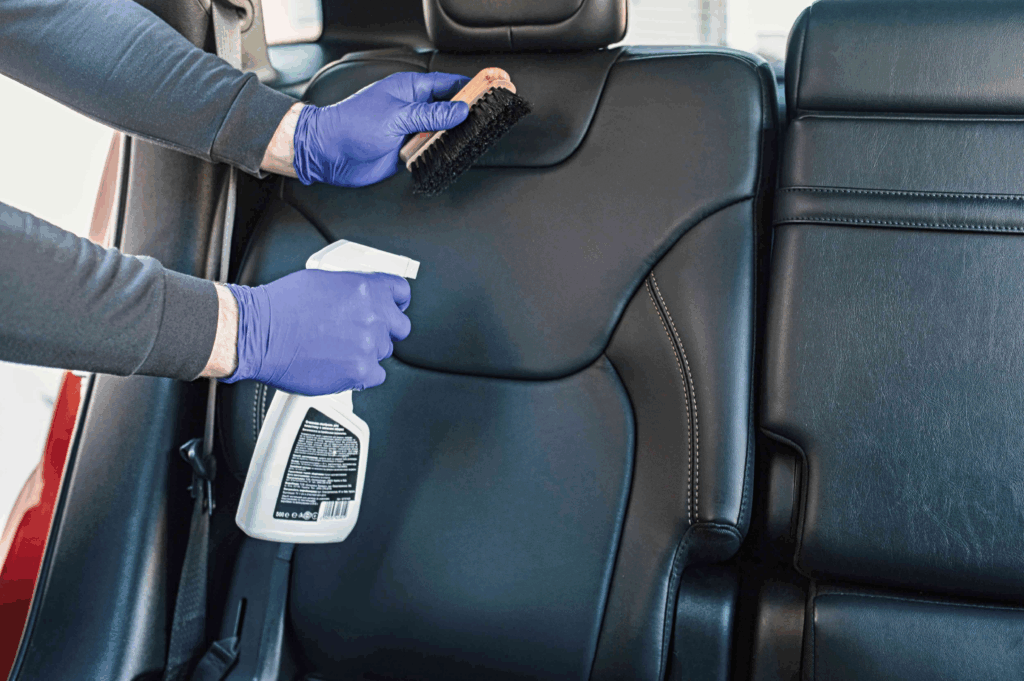Winter creates challenges for every car interior, especially leather seats. Low temperatures, road salt, moisture, and rapid temperature changes all affect the surface. Drivers often search for simple and effective ways to keep their seats clean and protected during the cold season. This guide covers Winter Leather Seat Care, Cold Weather Seat Cleaning, and practical Leather Seat Maintenance Tips to help your seats stay soft, pulito, and crack-free throughout winter.
Winter Leather Seat Care Basics: What You Must Know
Leather responds to winter differently than other materials. Cold weather pulls moisture from the surface, drying the fibers and making them stiff. Salt from clothes and shoes accelerates the problem because it sits on the surface and causes long-term discoloration.
Winter Leather Seat Care begins with a simple routine: cleaning, conditioning, and protection.

Why Winter Makes Leather More Sensitive
Leather becomes less flexible in low temperatures. Moisture freezes inside the fibers, and indoor heating quickly warms the surface, creating stress. A gentle, winter-specific cleaning method reduces the risk of cracks and dryness.
Winter Leather Seat Care: Best Cleaning Routine for Cold Weather
Cold Weather Seat Cleaning should be different from summer cleaning. Winter adds salt, mud, slush, and temperature shock. A careful step-by-step routine keeps the leather soft and smooth.
Step 1: Pre-Warm the Cabin
Before cleaning, warm the cabin to a mild temperature. Avoid blasting high heat. Gentle warmth softens the leather and makes cleaning easier.
Step 2: Remove Surface Dust and Salt
Salt is one of the biggest threats in winter. It dries the leather quickly and leaves white marks.
Use a soft microfiber cloth to remove dust and salt from the surface and seams. This protects the leather before applying cleaner.
Step 3: Use a Winter-Safe Leather Cleaner
Choose a cleaner designed for delicate or cold-weather use. Strong chemicals remove essential oils and make leather stiff.
Put the cleaner on a cloth and wipe using small circular motions. This prevents streaks and protects the material during Cold Weather Seat Cleaning.
Step 4: Dry the Seats Naturally
Use gentle cabin warmth to dry the leather. Avoid direct heat or hair dryers. Natural drying prevents surface cracks and prepares the leather for conditioning.
Winter Leather Seat Care: Conditioning for Cold Months
Conditioner replaces the oils that winter removes. A good winter routine always includes conditioning.
Choose a Conditioner Suitable for Winter

Select a water-based or natural-oil formula. These options absorb faster and don’t freeze. They support both Winter Leather Seat Care and Leather Seat Maintenance Tips.
Apply Thin, Even Layers
Use a small amount and massage it into the surface. Thick layers don’t add protection. Instead, thin coats help the conditioner penetrate deeper.
Focus on High-Wear Areas
Seat bolsters, outer edges, and stitching areas dry out the fastest. Apply extra conditioner to these sections to prevent fading and cracking.
Winter Leather Seat Care: Protection From Daily Winter Damage
Protection reduces your cleaning time and helps your seats last longer.
Use Seat Covers for Extra Protection
Custom-fit seat covers from Covers4Car shield leather from salt, moisture, and dirt. They keep the original seats clean and reduce winter damage. They also make Cold Weather Seat Cleaning easier because you only clean the outer cover.
Avoid Sitting With Wet or Snowy Clothing
Wet clothing lets moisture sink into seams. Shake off snow before sitting or place a small towel on the seat to keep the surface dry.
Keep a Microfiber Cloth in the Car
Quick wipes prevent long-term stains. This simple habit supports Winter car seat cleaning methods and reduces damage.
Leather Seat Maintenance Tips for Long-Lasting Results

Maintenance is more than cleaning. These steps help you care for your seats all winter.
Clean Every Two Weeks
Winter creates more dirt and salt than summer. A short cleaning every two weeks keeps your seats healthy and prevents buildup.
Avoid Strong Heat
Seat warmers and heaters remove moisture from pelle. Use lower settings to avoid dryness.
Avoid Overusing Cleaning Products
Gentle care gives better results. Too many chemicals layer on the surface and attract dirt. Stick to mild cleaners and soft cloths.
Store Cleaners and Conditioners Properly
Cold temperatures weaken formulas. Keep your products at room temperature for the best results.
Winter Leather Seat Care: Quick Emergency Cleaning Guide
Sudden winter messes happen often. Fast action protects the leather.
Fresh Stains
Blot the area gently with a dry cloth, then clean it with a mild leather cleaner.
Salt Stains
Mix warm water with a small amount of vinegar. Apply lightly, wipe, and condition the area afterward. This is one of the most effective Winter car seat cleaning methods.
Dry or Cracked Spots
Apply a rich conditioner and let it absorb overnight. Repeat if needed. Early treatment stops deeper cracks from forming.
Should You Clean Leather Seats More Often in Winter?

Yes. Winter produces faster wear and more dirt. Regular cleaning keeps the leather flexible and reduces cracking. A steady routine is the most effective Car leather protection guide you can follow.
How Covers4Car Helps With Winter Leather Seat Care
Offerte Covers4car coprisedili su misura designed for cold weather. They block salt, moisture, and everyday winter dirt. Using protective covers reduces cleaning time and adds a durable barrier that keeps your original seats safe.
Conclusione
Winter brings conditions that can easily damage leather, but a simple routine protects the material from dryness and cracking. With smart Winter Leather Seat Care, gentle Cold Weather Seat Cleaning, and consistent Leather Seat Maintenance Tips, your seats stay clean, flexible, and comfortable all season. Seat covers from covers4car add reliable protection and keep your car interior looking great through every winter drive.








